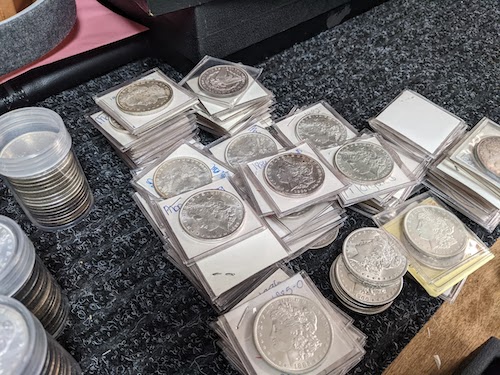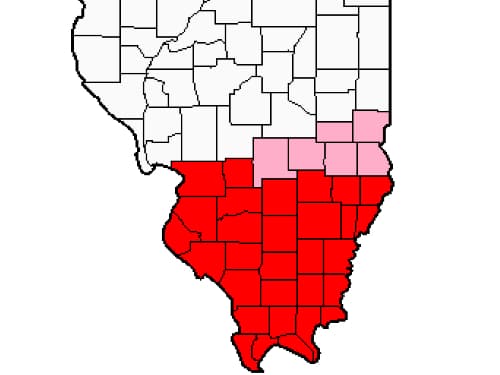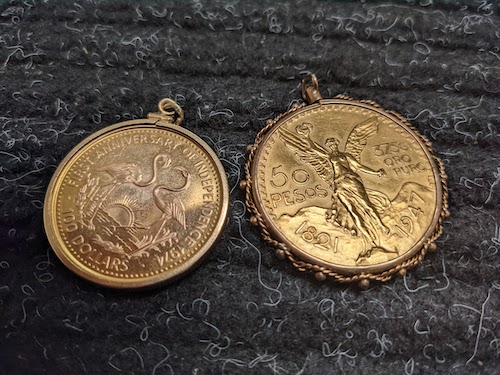Oakton Coins & Collectibles is one of the highest-rated coin shops in all of Illinois.
If you are considering selling your coin collection, you’ve come to the right place.
Oakton Coins and Collectibles understands that selling a single coin or a whole coin collection can be an extremely daunting task. Whether you’re a lifetime coin collector or have recently inherited a coin collection, when it comes time to sell your coins you have many options, and Oakton Coins & Collectibles can simplify the process. Although we’re located in Northern Illinois, many people from Southern Illinois mail us their collections as well. Usually, we communicate via email or texting regarding the appraisal. We always reimburse shipping costs and send you a check very quickly. Many people in Southern Illinois trust us with their valuables because of our track record of discretion and consistently high payments.
Understanding How to Sell Coins around Southern Illinois
When it comes to selling coins, you need to take a lot of factors into account. For instance, your coins could simply be worth face value, or they could be worth a significant amount of money. People don’t only collect valuable coins; often, they collect low-value or face-value coins for other reasons. But no matter the size or value of your collection, we’re here to help.
Sometimes, people sell their whole collection. Other times, they sell the valuable parts and split up the rest between relatives.
Often, people send us their coins carefully arranged by date and decade and placed in separate Ziploc bags or paper envelopes/coin tubes. You might be tempted to do this, but it’s not worth the effort.
When we appraise a collection, the first thing we do is separate coins by their composition (e.g., copper, nickel, silver, or gold). If you feel you must organize your collection, please put it into these groups:
- Gold coins
- 9o% silver dollars (1878 through 1935)
- 9o% silver dimes, quarters, and half dollars (1892 through 1964)
- 40% silver JFK half dollars (1965 through 1970)
- Lincoln wheat cents (1909 through 1958)
- Buffalo nickels (1913 through 1938)
- Jefferson nickels (1938 and later)
- All other obsolete U.S. coins
- U.S. mint proof and uncirculated sets
- U.S. mint commemorative sets
- Currency and paper money
- Foreign coins/tokens
Interesting coins are available for purchase in every budget range, so ask yourself the following questions to help determine your collection’s value:
- Can you determine how much money the collector spent or how regularly the owner bought?
- Can you find any bills of sale, invoices, or canceled checks from dealers or auction firms?
- Do you have an insurance policy or a will with instructions?
This information may be helpful, but you can’t completely depend on any of it. The value of coins (and collectible paper money), like the value of anything else, is what a willing buyer will pay a willing seller. This amount is never a fixed figure, as the market fluctuates in varying degrees and at unpredictable rates.
Pricing Your Collection to Sell around Southern Illinois
Ninety-nine percent of the time, you won’t receive the value listed in any of the pricing guides that you may reference when you sell coins. The guides are simply a way to help you establish the price range you can reasonably expect for a coin. Most consumer guides show extremely inflated values.
Keep these coin-selling terms in mind: clickbait pricing, real-world pricing, melt-value pricing, and numismatics pricing.
Clickbait Pricing: Wikipedia defines “clickbait” as web content that is aimed at generating online advertising revenue, especially at the expense of quality or accuracy. This pricing relies on sensationalist headlines to attract click-throughs. Click-throughs refer to when the reader clicks a link to go through to the next stage of the bait. Clickbait creators love to post about how common coins could be worth big money, but in reality their claims are almost never valid.
Real-World Pricing: Real-world pricing refers to actual money changing hands. This pricing reflects amounts that have actually been paid, not just advertised, so it’s true market value. Everything else is just a bunch of words and ideas about value. Any coin is only worth what someone will pay for it, and collectors usually focus on rarity and condition to determine monetary value.
Melt-Value Pricing: Prior to 1965, the majority of United States coins contained either gold or silver (with a few exceptions). Any selling premium on top of the melt value comes from the numismatic value.
Numismatics: Numismatics is the study of coins, paper currency, and metals. Coin rarity and condition drive the prices that collectors will pay. Regardless of their metal composition, some coins have a very high numismatic value.
Places NOT to Sell Coins around Southern Illinois
- Jewelry Stores and Pawn Shops – These places usually only understand the precious metal part of gold/silver coins, and they pay only a small percentage of that price.
- eBay – Many coins are sold on eBay every day, but doing so can be very risky, time consuming, and costly. Click here for more information.
Sell Coins near Me – Southern Illinois
Oakton Coins is conveniently located right near 94 West (Kennedy) near downtown Skokie (very close to Chicago), and less than two blocks from the Oakton stop on the Yellow Line CTA (Skokie Swift). Alton, Centralia, Collinsville, Edwardsville, Glen Carbon, Godfrey, O’Fallon, Harrisburg, Herrin, West Frankfort, Mt. Vernon, Marion, and Carbondale.
Glossary of numismatic terms, A;
About Good – A grading term describing a coin that is less than Good. Only the main features on the surfaces are visible. Typically, peripheral lettering, date, stars, or other features are partially worn away. Abbreviated as AG and numerically assigned the number 3.
About Uncirculated – A grading term describing a coin that initially appears to be Uncirculated, but upon closer inspection a little rub or friction can be seen. Abbreviated as AU. Numerical equivalents associated with About Uncirculated are: AU-50, 53, 55, and 58, with AU-50 being the lowest grade and AU-58 being borderline Uncirculated.
Abrasion(s) – Area(s) of a coin where a foreign object or another coin has displaced metal in an abraded fashion. Not the same as hairlines or bag marks.
Accolated – Overlapped impression, as with two or more portraits on the face of a coin. Example: The 1900 Lafayette commemorative silver dollar bears the accolated portraits of Washington and Lafayette.
Accumulation – A group of miscellaneous and random coins, often a monetary hoard, not a coin collection. This term may also refer to a grouping of a particular series, date or type such as an accumulation of Walking Liberty half dollars.
Ace – Numismatic nickname for a $1 bill, particularly a $1 National Bank Note of the Original Series or the Series of 1875.
Adjectival Grading; Adjectival Grading System – The traditional grading system employed until superseded by the numerical grading system. Coins in grades from the most worn (Poor) were described adjectivally in these progressive steps: Poor, Fair, Good, Very Good, Fine, Very Fine, Extremely Fine, About Uncirculated, and Uncirculated. Modifiers such as “choice” and “gem” were sometimes used to indicate an especially nice specimen within a grade level, such as Choice Extremely Fine or Gem Uncirculated.
Adjustment Marks – Small, straight (never curved) striations or file marks found on early United States coins. Caused during planchet preparation (before striking) by drawing a file across the coins to remove excess metal so as to reduce the planchet to its proper weight. The result is a series of parallel grooves.
Aesthetic Appeal – Term used to indicate the artistic or visual desirability of a coin in addition to its numerical or technical grade. Synonym: eye appeal.
AG, AG-3 – Designation for About Good.
Agricultural Wreath – A wreath motif created by James B. Longacre and used on the 1854 Type II gold dollar, 1854 $3 gold coin, 1856 Flying Eagle cent, and other issues. Wreath of corn (most prominent), wheat, cotton, and tobacco—called a cereal wreath by Mint Director Snowden in his 1860 book, A Description of Ancient and Modern Coins in the Cabinet Collection of the Mint of the United States. Called tobacco wreath by Edgar H. Adams, The Numismatist, July 1912, pp. 246-247.
AGW (Actual Gold Weight) – An infrequently used term for the weight of pure gold that is in a coin, medal or bar. In contrast, the gross weight of a gold coin includes the weight of alloys.
Album Friction – Evidenced by a slight rubbing on a coin’s high points, similar to but not as severe as album slide marks. When repeatedly removed and inserted into albums with clear slides, the slides can impart horizontal scratches if they touch the coin’s surface. To prevent this, carefully push the coin well into the hole so the slide does not touch it.
Album Slide Marks – Lines on the surface of a coin, usually parallel, caused by the plastic “slide” of a coin album.
Alchemy – The transmutation of base metals such as lead and mercury into gold; practiced in historic times by various chemists, pretenders, etc.
Alloy – Copper and sometimes silver are mixed with gold to add strength and durability to a coin, and the resulting metal is called an alloy. Coins made of pure gold are very soft, and easily scratched, worn and damaged.
All-Seeing Eye – Eye motif, usually surrounded by resplendent rays. Used on certain copper coins of the 1780s such as the 1783-1786 Nova Constellatio coinage, the 1783 Nova Constellatio silver patterns, the 1785-1786 Landscape-type Vermont coppers (Ryder 2 through 8), and, in more modern times, the small-size $1 note (included as part of a pyramid design, no rays surrounding).
Almost Uncirculated – Another grading term for About Uncirculated.
Alteration – The tampering with a feature of a coin’s surface such as the date, mintmark, etc. to give it the appearance of being another date, mintmark, or variety. An unethical and sometimes illegal practice.
Altered Surfaces – When the surfaces of a coin have been affected by cleaning or other processes resulting in it being less desirable to collectors.
Aluminum – An elemental metal. Aluminum was a precious metal in the 1850s, but by the 1860s came into limited use to strike patterns as well as delicacies for collectors. Aluminum tended to oxidize quickly, forming a protective gray coating, which then stabilized and endures in many instances to the present day. In 1973 the Mint contemplated using aluminum for regular coinage of cents, since copper was rising sharply in price on the commercial market. About a million and a half Lincoln cents were struck with the date 1974, and some were given out as samples, but the metal was never used for regular coinage.
American Auction Association – 1970s auction division of Bowers and Ruddy Galleries. This name was discontinued, and later catalogs bore the Bowers and Ruddy Galleries name.
American Eagle – A series of bullion coins created by the U. S. Mint featuring a family of eagles on the reverse. The silver coins were introduced in 1986 in a $1 denomination. The gold coins were first produced in 1987 in 1/10, ¼, ½, and 1 ounce versions.
American Numismatic Association – A nonprofit educational organization founded in 1888, dedicated to encouraging the study and collecting of money and related items. The ANA helps people discover and explore the world of money through a vast array of programs including education and outreach, museum, library, publications, conventions, and seminars. They are headquartered in Colorado Springs, Colorado. Read more about them at money.org.
American Numismatic Association Grading System – Adopted in 1977, the ANA Grading System was described in the book, Official ANA Grading Standards for United States Coins, and evaluated coins based upon the Sheldon scale for grading.
American Numismatic Association Hall of Fame – Pantheon and gallery located at the American Numismatic Association Headquarters, Colorado Springs, CO. Numismatists past and present who are deemed worthy and elected for the honor are enshrined by being included in the exhibit, a highly desirable honor. The first honorees enshrined in 1969 were: Edgar H. Adams, George J. Bauer, Frank G. Duffield, Dr. George F. Heath, Edward T. Newell, Wayte Raymond, David C. Wismer, Howland Wood, and Farran Zerbe.
American Numismatic Association Headquarters – A.k.a. ANA. Headquartered at: North Cascade Avenue, Colorado Springs, CO, on the campus of Colorado College. Built in the 1960s on land leased for $1 per year for 100 years (option of 100 years renewal) from the college. Action center for executive, editorial, membership, museum, authentication, and other functions. Focal point for exhibits, seminars, other events.
American Numismatic Society – A museum and research institute devoted to the study of coins from all periods and cultures. They are headquartered in New York City, New York. Abbreviated as “ANS.”
ANA – An abbreviation for the “American Numismatic Association.”
ANACS – (American Numismatic Association Certification Service) – An authentication service started by the ANA that later provided grading services. The ANA later sold the acronym and this service, which now operates as a third-party grading service.
ANACS Certificate – Issued by the ANA Certification Service, a written document of authenticity and/or grade that bears a unique number.
Ancients – A term for world coins struck circa 600 B.C. to circa 450 A.D.
Annealing – A process by which a die or planchet is heated and then cooled to soften the metal for die preparation or the striking of a coin.
Annular – Ring like, ring form. Refers to a coin with a circular perforation or hole at the center, certain pattern cents of 1850 being examples.
Annulet – In heraldry and in numismatic descriptions, a small ring or related emblem as part of a design.
ANS – An abbreviation for the “American Numismatic Society.”
Anvil Die – Usually the reverse of the coin, the lower, stationary die. On some issues with striking problems, the obverse is used as the lower die. Due to the physics of minting, the stationary lower-die impression is slightly better struck than the upper-die impression.
Arcade Tokens – Metallic tokens used in penny arcades, amusement emporiums, and related places. Sometimes bearing a denomination, these tokens could be used in place of cents, nickels, quarters, or other coins in coin-operated devices.
Argentan – A variety of “German silver,” an alloy without silver, which contains a mixture of nickel, tin, copper, and other metals.
Arms – In heraldry, on banknotes, and on coins and medals, the representation of a state, family, or other entity, often incorporating a shield with patterns and designs, so as to permit easy identification of that entity. Certain state copper coins, commemoratives, and other United States issues included arms of various states.
Arrow and Rays – Term referring to a design element on quarters and half dollars dated 1853. The rays were removed the following year due to striking difficulties created by the complicated design.
Arrows – Design element seen on many U.S. coins, most frequently in the eagle’s left claw.
Arrows at Date – The arrows to the left and right of the date on a coin. The Mint added these to the dies to indicate a weight increase or decrease.
Artificial Toning – Toning or patination applied to a coin by chemical, heat, or other means to decrease its brightness or brilliance and to give it the appearance of having acquired attractive colors over a long period of time. Such coins are plentiful in the marketplace, including in certified holders, and a keen eye is needed to identify them.
Ask – The price that represents what a seller is willing to accept for a particular coin issue and grade. This changes with market fluctuations. See also: Bid; Spread
Assay – To evaluate and calculate the purity of a metallic alloy.
Assay Bar, Assay Ingot – A rectangular (usually) ingot or bar of silver or gold, produced by an assay office (see listing) and stamped with data, usually including the name of the assayer, weight, fineness (purity), metal, a serial number, and, sometimes, the date and market value.
Assay Office – A facility established by the federal government or by private individuals to receive and evaluate precious metals, especially gold, silver and copper. The government operated assay offices in Butte (Montana), New York City, Denver, and elsewhere. During the Gold Rush several assay offices did good business in California, including Kellogg & Humbert, Harris & Marchand, Justh & Hunter, Moffat & Co., and the United States Assay Office of Gold, among others.
Assayer – One who performs assays. Position at the Mint from 1792 onward. Most assayers operated in the private sector, however, especially in the conduct of business in assay offices, mines, refineries, etc.
Athena – Goddess symbolic of Athens. Athena and her owl (denoting wisdom) are motifs on the 1915-S commemorative $50 gold coins, round and octagonal formats, issued for the Panama-Pacific International Exposition in San Francisco.
Attributes – The components that determine a coin’s grade, primarily marks (or hairlines for Proofs), strike, eye appeal, and luster.
Attribution – The assigning or referencing of a coin to its source, engraver of its dies, or of its die variety as described in a numismatic work. Example: United States copper cents of the 1793-1814 years can be attributed to Sheldon numbers, as, for example, S-48, as delineated in Early American Cents, Dr. William H. Sheldon, 1949.
AU – An abbreviation for “About Uncirculated.”
Auction – An offering of numismatic items for sale to the highest bidder, rather than ordering from a catalog, price list, or advertisement at a fixed price.
Auctioneer – The person who recognizes and accepts bids during an auction.
Authentic – A numismatic item that is genuine and was produced at the time and place to which it has been attributed.
Authentication – The process by which a determination is made as to whether a coin or other numismatic item is genuine.



